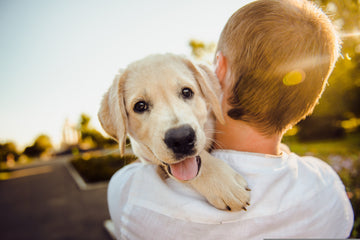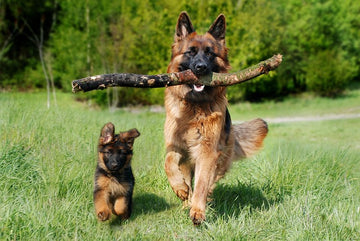10 Essential Tips for First-Time Dog Owners
Bringing home a new dog is an exciting and life-changing experience. However, if you're a first-time dog owner, it can also be a bit overwhelming. To help make the transition smoother for both you and your furry friend, here are 10 essential tips to ensure a happy, healthy relationship with your new companion.
1. Choose the Right Breed
Every dog breed has unique traits, temperaments, and care needs. Before bringing a dog into your home, consider the breed that best fits your lifestyle. Active individuals may prefer a high-energy breed, such as a Border Collie or Labrador Retriever, while those living in apartments might benefit from a smaller, low-energy dog like a French Bulldog or Cavalier King Charles Spaniel. Research different breeds and their characteristics, including size, grooming needs, and temperament, to find the best match for your home and family. Remember, adopting from a shelter or rescue can provide a loving home to a dog in need, regardless of breed.
2. Schedule a Vet Checkup
After bringing your dog home, schedule a veterinary appointment as soon as possible. A comprehensive health check ensures your new pet is healthy and provides an opportunity to discuss vaccinations, flea and tick prevention, and deworming. Your vet can also help you establish a vaccination schedule that is right for your dog’s age and breed. Regular vet visits are crucial for monitoring your dog's health and addressing any concerns early on, as many health issues can be more effectively managed when detected early.
3. Puppy-Proof Your Home
Puppy-proofing your home is essential to keep your dog safe and protect your belongings. Remove hazardous items such as electrical cords, cleaning supplies, and any small objects that could be choking hazards. Use baby gates to block off areas of your home that are off-limits, and provide chew toys to keep your dog entertained. Consider securing trash cans and removing any plants that may be toxic to dogs. Additionally, create a designated space for your dog, such as a cozy bed or crate, where they can feel safe and relaxed.
4. Create a Routine
Dogs thrive on routine. Establish a consistent schedule for feeding, bathroom breaks, and exercise. This helps your dog feel secure and understand what to expect from their day. A well-structured day makes housetraining easier and reduces behavioral issues caused by anxiety or boredom. Try to wake up, feed, walk, and play with your dog at the same times every day. This predictability not only benefits your dog’s behavior but also strengthens your bond with them.
5. Start Basic Training Early
Training is essential for a well-behaved dog. Start teaching basic commands like "sit," "stay," and "come" early on. Use positive reinforcement, such as treats and praise, to encourage good behavior. Consistency is key, so make training sessions short, fun, and engaging for your dog. Consider enrolling your dog in a puppy training class, where they can learn basic commands while socializing with other dogs. Remember, training is not just about obedience; it also builds trust and strengthens your relationship with your pet.
6. Feed a Balanced Diet
A nutritious diet is crucial for your dog's health and well-being. Consult your vet to determine the best food for your dog's age, breed, and health needs. Ensure you are providing high-quality dog food that meets their nutritional requirements, including protein, fats, carbohydrates, vitamins, and minerals. Be cautious of overfeeding, as obesity can lead to serious health issues. Always have fresh water available, and consider incorporating fruits and vegetables as treats, ensuring they are safe for dogs.
7. Provide Regular Exercise
Exercise is vital for your dog's physical and mental well-being. Different breeds have varying exercise needs, so tailor your dog's activity level accordingly. Regular walks, playtime, and mental stimulation will keep your dog happy and healthy. Engage in activities like fetch, agility training, or even swimming, depending on your dog’s preferences. Socializing with other dogs during playdates can also be beneficial, allowing them to burn off energy while building social skills.
8. Socialize Your Dog
Socialization is critical for your dog's development. Expose your dog to different people, environments, and other animals from a young age. This helps reduce anxiety and fear in new situations, making your dog more adaptable and confident. Puppy classes are a great way to socialize your dog while providing training. You can also visit dog parks, host playdates, or take them on outings to pet-friendly places to broaden their experiences.
9. Prioritize Grooming
Regular grooming is essential for your dog's hygiene and comfort. Brush your dog's coat regularly to remove loose hair and prevent mats. Different breeds have different grooming needs, so be sure to research what’s best for your dog. Check their nails, ears, and teeth regularly to ensure they remain healthy. Establish a grooming routine early to help your dog get used to the process. Bathing should be done as needed, using dog-specific shampoos to keep their coat clean and healthy.
10. Build a Strong Bond
Building a strong bond with your dog is essential for a fulfilling relationship. Spend quality time together through play, training, and cuddling. Establish trust by being consistent and patient. Engage in activities that you both enjoy, whether it’s going for walks, hiking, or simply lounging together at home. Your dog will thrive on the attention and love you provide, and the stronger your bond, the more responsive your dog will be to your commands and training.
By following these essential tips, you’ll create a loving and nurturing environment for your new dog, leading to a happy and fulfilling life together. Remember, patience, understanding, and love are key to a successful pet ownership experience! With time, you will learn more about your dog's unique personality and needs, making your relationship even more rewarding.





